What are dentures?
Dentures are removable appliances to replace one or more missing teeth.
They are cost-effective and non-invasive, and rest on the upper or lower jaw bones, or both.
Our dentures are manufactured in Australia from high quality materials and provide a natural appearance.
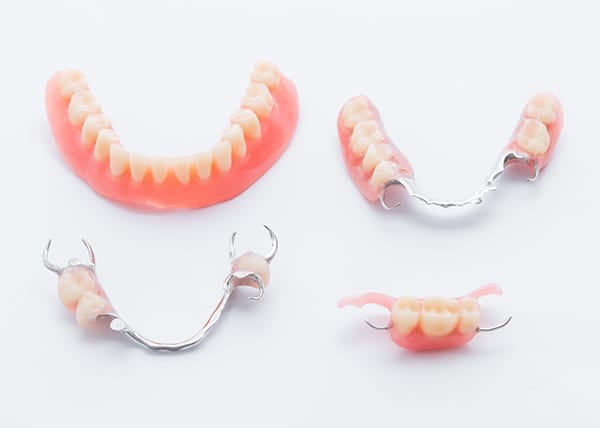
Types of dentures
There are two types of non-invasive dentures available:
- Complete (full) dentures, and
- Partial dentures.
Complete dentures are used to replace all the teeth on either the upper or lower jaw, or both. They are supported solely by the gums.
Partial dentures are used to fill gaps from one or more missing teeth surrounded by remaining natural teeth. Partial dentures are a removable alternative to dental bridges. They are supported by both the gum tissue and the adjoining teeth. ‘Partial dentures’ is an abbreviation for ‘removable partial dentures’ or RPD.
Alternative to traditional dentures (removable):
An alternative to traditional dentures is an overdenture, also called an implant-supported denture.
An overdenture is a removable complete (full) denture that is attached to fixed dental implants. A regular complete denture is supported by only gum tissue, whereas an overdenture is supported by both the gum tissue and the dental implants.
It’s important to note that overdentures are not fixed appliances. They need to be removed daily to be cleaned, and must not be worn during sleep.
Alternative to dentures (permanent):
If you are after a permanent alternative to overdentures, we also offer fixed full-arch prosthesis (dental bridges). You may have heard of these as “all-on-4” or “all-on-6” dental implants. These implants can safely support a whole arch of permanent, natural looking artificial teeth. This procedure does not require bone grafting as some of the implants are inserted on an angle, therefore it is suitable for many patients. The prosthesis (bridge) can be made out of ceramic or acrylic, and may or may not include natural-looking artificial gum depending on a number of factors (including how much bone height is available).
You can read more about implant-retained full-arch bridges on our dental implants page here.
All-on-6 bridge prosthesis images:
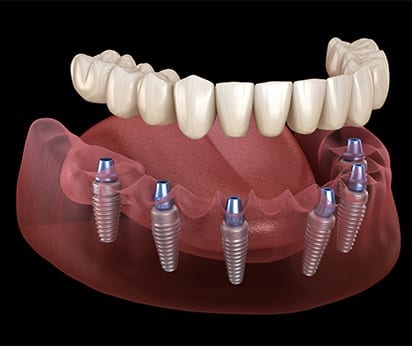
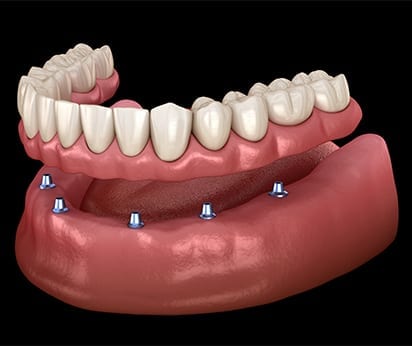
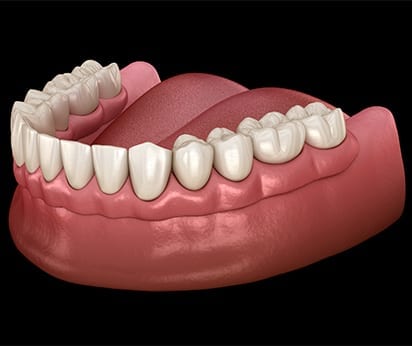
Complete dentures, Partial dentures and Overdentures
Complete (full) dentures
Complete dentures are made from acrylic (plastic).
They consist of two components, the artificial teeth and the artificial gum base. They are a total replacement for all teeth on the upper or lower arch (jaw), or both. Complete dentures also provide support to your face by giving it a more natural, ‘filled-in’ look.
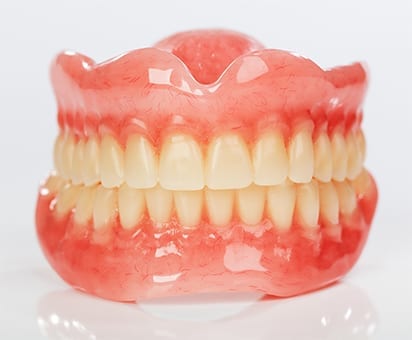
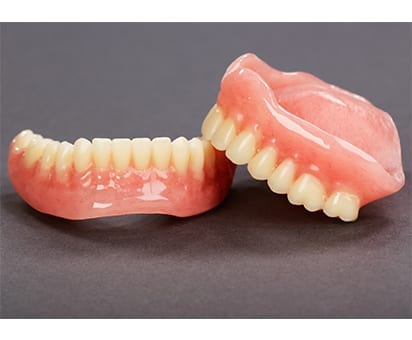
Partial dentures
A partial denture replaces one or more missing teeth on the upper or lower arch (jaw). They attach to the remaining adjacent teeth either with metal clasps, or for crowns and bridges precision attachments can be used. Attaching to the remaining teeth helps keep the denture in place, and improves stability and support.
Partial dentures are made from plastic (acrylic) for the artificial teeth and gums, and lightweight metal (cobalt chrome) for the framework.
The benefits of a metal (cobalt chrome) framework include:
- Stronger than plastic (acrylic) so it can be made thinner and smaller, which results in a less bulky denture.
- Gives a closer fit onto existing teeth.
- Helps distribute the force load during biting more evenly, protecting the underlying bone.
Metal framework also provides enough retention that your palate can be left uncovered.
This has a number of advantages including:
- Taste of food is better.
- More comfort during eating as you can feel the texture/temperature of foods on your palate.
- More comfort whilst wearing the denture as it doesn’t go far back in your mouth.
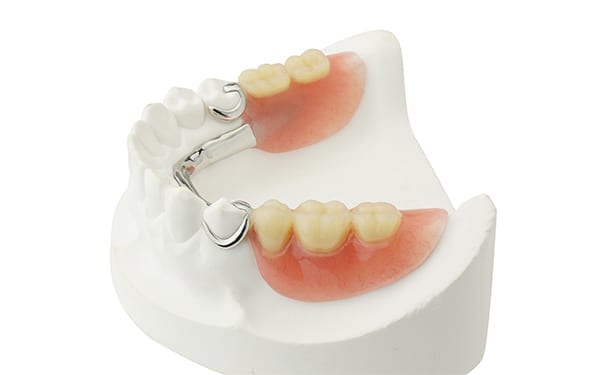
Partial denture with metal clasps (video):
Partial denture with precision attachments (video):
Overdentures
An overdenture (or implant-supported denture) is a removable complete denture that is attached to fixed dental implants. Usually two implants are used. The denture has special attachments that snap onto (and off) the implants.
Overdentures are a more stable solution to traditional dentures and offer enhanced support, comfort and durability. They can help reduce shrinkage of the jawbone, preserve facial structure, and distribute the force load during biting more evenly which both stabilises the denture and helps protect the underlying bone.
Overdentures are removable appliances which must be removed daily to be cleaned, and must not be worn during sleep.
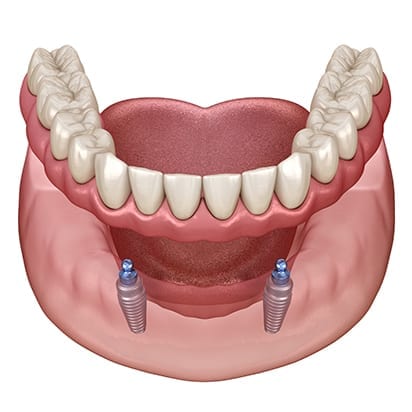
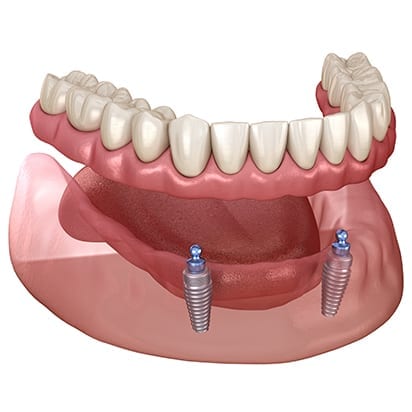
Overdenture (video):
Denture procedure
Complete or partial dentures:
Your denture(s) will be completed over a series of appointments to ensure the best fit and finish.
Firstly, detailed impressions of your teeth and/or gums are taken. These will be sent to the dental laboratory to begin manufacturing the denture(s) to your exact model.
At your next appointment we record your MMR (maxilla mandibular relationship), which is your bite position, on wax bite blocks. This allows us to get your occlusion (how your teeth bite together) correct in relation to your jaws and facial anatomy, and ensures the denture will provide proper support for your facial muscles. We will also select the tooth shape and shade for the denture(s). Depending on your particular case, the dental laboratory may have made you special trays. If this is the case, we use these trays to create a more refined impression for your denture(s). The MMR blocks, tooth shade and design, and if relevant the trays, will then be sent back to the dental laboratory to continue your denture fabrication.
The denture(s) will firstly be made in wax, so you can try them in at a trial assessment appointment. This allows us to make any adjustments necessary to ensure you are happy with the fit and appearance. Once you are happy with the design, it is sent back to the laboratory to be completed with permanent acrylic base material and high-quality artificial teeth.
Once the final denture is complete, you will attend another appointment where the denture will be tried and fitted, and you can wear it home.
You will attend a review appointment around one week later so we can make sure you are entirely comfortable with the denture. We can also make any small adjustments if required.
Overdentures:
There are two types of implant attachments (abutments) available for overdentures: bar-retained and ball-retained. Your dentist will discuss the features of both options with you to find which will be the best suitable.
Firstly the dental implants are placed and then allowed time to heal.
Once healed, the tops of the implants are exposed so we can attach the mechanism that will allow the denture to be locked on.
Once the soft tissue has healed around the denture attachments, the procedure is largely the same as that for complete or partial dentures.
Detailed impressions of your teeth and/or gums (and the implant attachments) will be taken. These will be sent to the dental laboratory to begin manufacturing the denture(s) to your exact model.
We will then record your MMR (maxilla mandibular relationship), which is your bite position, on wax bite blocks. This allows us to get your occlusion (how your teeth bite together) correct in relation to your jaws and facial anatomy, and ensures the denture will provide proper support for your facial muscles. We will also select the tooth shape and shade for your denture(s). Depending on your particular case, the dental laboratory may have made you special trays. If this is the case, we use these trays to create a more refined impression for your denture(s). The MMR blocks, tooth shade and design, and if relevant the trays, will then be sent back to the dental laboratory to continue your denture fabrication.
The denture(s) will firstly be made in wax, so you can try them in at a trial assessment appointment. This allows us to make any adjustments necessary to ensure you are happy with the fit and appearance. Once you are happy with the design, it is sent back to the laboratory to be completed with permanent acrylic base material and high-quality artificial teeth.
Once the final denture is complete, you will attend another appointment where the denture will be tried and fitted, and you can wear it home.
You will attend a review appointment around one week later so we can make sure you are entirely comfortable with the denture. We can also make any small adjustments if required.


